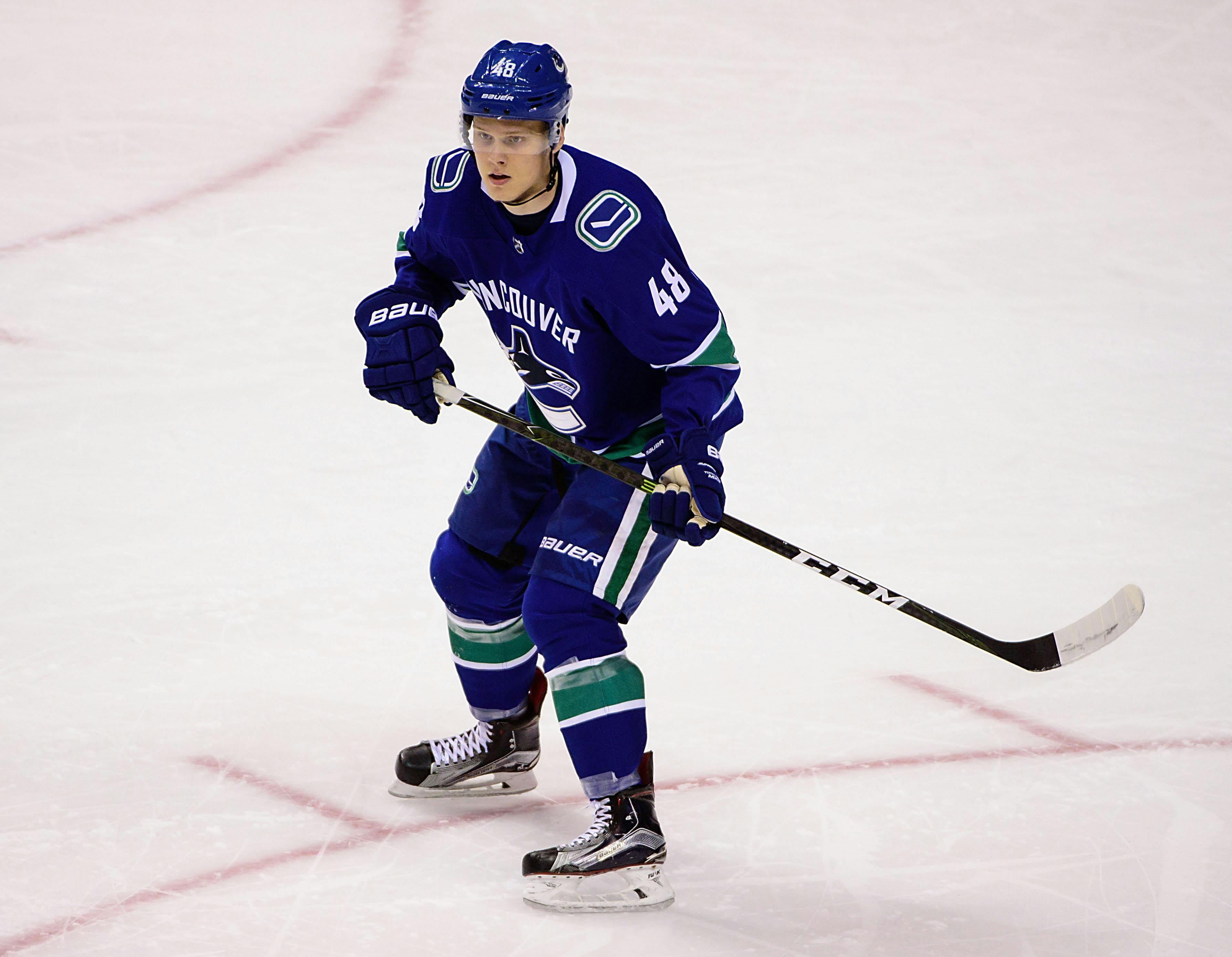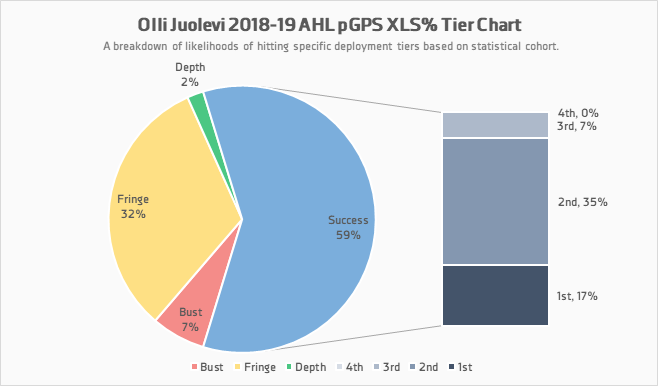2019 Preseason Prospect Rankings: #5 Olli Juolevi

4 years ago
Next up on our countdown of the best prospects in the Canucks’ system is Olli Juolevi, a player who, if not for Jake Virtanen, would be far and away the most polarizing Canucks’ first-round pick in recent memory.
Juolevi debuted in the #2 spot on our annual rankings back in 2016, but his inability to make a significant impact in North America (mainly due to injury trouble) has caused him to take a tumble since then, clocking in at the fifth overall spot on this year’s preseason rankings.
Even as someone who was never that high on Juolevi, that seems low to me. There may be a few players in the Canucks’ system that have more upside at this stage in their development than Juolevi does, but aside from the two prospects virtually every expert agrees should be at #1 and #2, he’s still got the best shot of being a fixture in the team’s lineup for years to come.
Qualifications
In keeping with past lists, we’re considering a prospect to be any player who is 25 years of age or younger and who has played less than 25 regular season games at the NHL level. This is a slightly modified and simplified version of the qualifications for the Calder Trophy.
As of the 2018/19 season, both Elias Pettersson and Adam Gaudette have graduated from prospect status.
By the Numbers
| TEAM/LEAGUE | SEASON | GAMES | GOALS | ASSISTS | POINTS | PIM | +/- |
| UTICA/AHL | 2018/19 | 18 | 1 | 12 | 13 | 2 | -12 |
For a player who’s generally been regarded as a disappointment over the years that have passed since his selection, draft analytics look very kindly on Juolevi. Jeremy Davis’ prospect Graduation Probabilities System gives Juolevi an expected likelihood of success of 59.4%, a top 4 XLS of 52.2%, and an expected production rate of 35.1. The successful players in Juolevi’s cohort are a murderer’s row of top four defensemen of all play styles that includes Mike Green, Shea Theodore, Justin Faulk, T.J. Brodie, Roman Josi, and Keith Yandle.

Thanks to an impressive production rate over his brief AHL stint last year, these are actually the highest pGPS numbers Juolevi has posted since his draft year.

The majority of the successful players in Juolevi’s cohort went on to become second-pairing defensemen at the NHL level, which is a great sign for a player whose pro career has gotten off to a rocky start. The sample is extremely small and has likely inflated his true value, but if Juolevi can develop into even an average second-pairing defenseman, that would go a long way towards reclaiming some of the opportunity cost in using a fifth overall selection to select him.

At this point, it seems more than fair to call a spade a spade and concede that selecting Juolevi with the fifth overall pick in 2016 hasn’t worked out the way the team had hoped. The next 12 players selected immediately after Juolevi have all at the very least made appearances in the NHL, and many have already reached legitimate top-six or top-four status. Even if Juolevi absolutely shatters expectations and becomes a top-pairing defenseman at some point in the near future, it would take years of him playing at that level for him to match the value of the 3+ extra seasons the Flames have gotten out of Matthew Tkachuk or the 2+ seasons the Lightning have gotten out of Mikhail Sergachev.
Obviously, a good chunk of this was outside of the team’s control. There’s no way anyone in the team’s scouting department could have predicted that Juolevi would have two major surgeries before turning 21. Still, there were early signs that the hype surrounding Juolevi in his draft year wasn’t lining up with his accomplishments and frankly, I think CanucksArmy and the draft analytics community on the whole really missed the boat by not questioning the pick more at the time. That criticism applies to myself, too. I was a brand new contributor at the time of the 2016 draft and despite noticing a few red flags in Juolevi’s underlying profile, I was gun-shy about taking on seasoned NHL scouts as a relatively inexperienced blogger.
Despite playing on one of the most offensively potent teams in OHL history, Juolevi was actually one of the lower-scoring CHL defensemen taken in the top ten over the past decade. 18 CHL defensemen have been selected in the top 10 over the last decade, and of those players, seven put up a lower points-per game total: Jared Cowan, Erik Gudbranson, Dylan McIllrath, Ryan Murray, Griffin Reinhart, Slater Koekkoek, and Haydn Fleury. Of those seven, only Ryan Murray has really been able to perform well enough at the NHL level to avoid being labeled a write-off as a top-ten pick.
Scouting Report
In retrospect, Juolevi’s draft stock seems to have been significantly inflated simply because he had the good fortune of being the top defender on two historically great junior teams. In London, Juolevi fed passes to a top line of Mitch Marner, Christian Dvorak, and Matthew Tkachuk, all of whom would go on to make a significant impact in the NHL the following year. At the 2016 World Juniors, Juolevi benefited from playing with another stacked forward group that included Patrik Laine, Mikko Rantanen, Sebastian Aho, and Kasperi Kapanen.
Obviously, Juolevi had to be pretty talented in his own right to earn the chance to play alongside future superstars; but you have to wonder how much of the hype surrounding Juolevi in his draft year was the result of coattail-riding, especially because the consensus among scouts has always been that hockey sense is his best attribute. It’s easier to look like you’re always in the right place at the right time.
Still, there is something special about the way Juolevi sees the ice. I’ve been fortunate enough to get the opportunity to see him play in person and pick up some of the little things in his game that don’t come through nearly as much on tape. He’s calm under pressure, seemingly always one step ahead of the opposition, and able to draw in opposing forwards to open up space for his teammates. He looks poised with and without the puck and never seems to break a sweat, even when moving at top speed.
One of the most frustrating things about the discourse that surrounded Juolevi at the time of the 2016 draft was that scouts never seemed to agree on his play style. You were as likely to speak to someone who believed he was a future power play quarterback in the making as you were to find a scout who thought he was the next Chris Tanev.
When I’ve watched Juolevi, I’ve always left thinking that the high-end offensive upside some scouts believed he possessed as the top defender in London was never really there. He’s a smooth skater who can make a great first pass and pick up a few secondary assists on a power play, but mostly as a passenger.
It’s been a while since I’ve had gotten a good look at Juolevi, having only had a very brief chance to see him play at the AHL level; so I reached out to Cory Hergott, who’s had more chances to catch Juolevi at the latest stage in his development. His assessment did not differ all that much from mine:
I [see] him as a Dan Hamhuis type. He did nice work on the PP, but a lot of that has to do with Reid Boucher’s shot. Don’t get me wrong, he did some nice things offensively, but I think that anyone expecting him to continue at a pace where he’s putting up 13 points every 18 games is setting themselves up for disappointment. I think he will provide offence, but not at the rate he did last year. In my opinion, he needs to make his reads more quickly and he needs to tighten up his gap control. He was only 18 games into the league though, so I expect that it will take time for him to be more comfortable and be able to clean that stuff up. His first 20 games or so this year will say a lot about where his knee is at as far as being ready for heavy minutes and the pace/physical impact that he will be putting it through.
I’m not breaking new ground by suggesting that Juolevi bears some similarity to Jake Virtanen, another recent first-round selection by the Canucks who has failed to live up to the loft expectations that come with a top-ten selection. I even spoke to one scout in early 2017 who believed the Juolevi selection had the potential to be an even greater disappointment than the Virtanen one. I understand that sentiment, but I also think circumstances have conspired to make the situation appear more dire than it actually is. Barring another catastrophic injury, Juolevi is going to see some playing time with the Canucks in the near future, and should be pretty close to making the jump to the NHL. The same can’t really be said for players like Jett Woo and Nils Hoglander yet, despite the fact that many prognosticators (including some of my colleagues here at CA) have begun to give those players the edge over Juolevi as prospects.
When it comes to Olli Juolevi, it’s important that we all exercise our ability to hold two thoughts in our heads at the same time. A prospect can be simultaneously disappointing relative to where he was selected and an important piece of the puzzle moving forward. At this point, Cory’s comparison to Dan Hamhuis is probably the best-case scenario, but even if all Juolevi amounts to is a cost-controlled #5 defenseman, that’s far more than most prospects ever achieve; and the fact that things haven’t played out the way fans had envisioned back in 2016 doesn’t change the fact that Juolevi is still one of the best prospects in the Canucks’ system.





